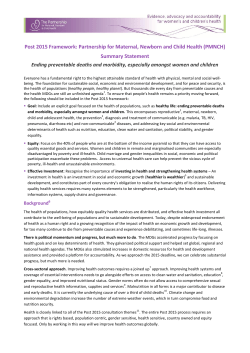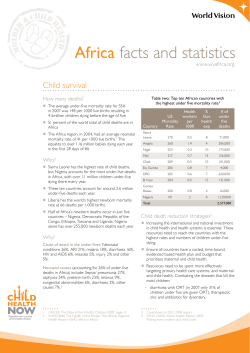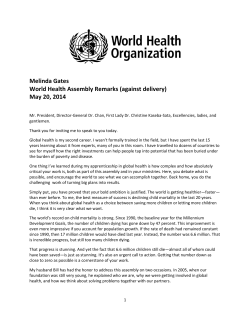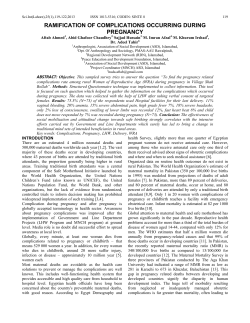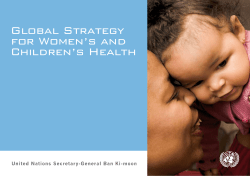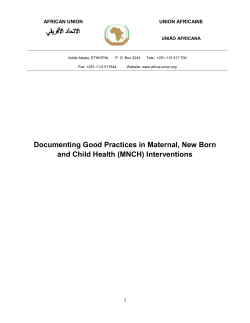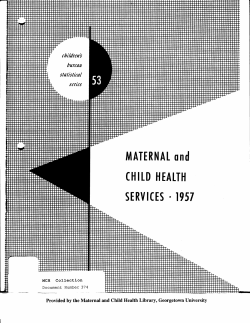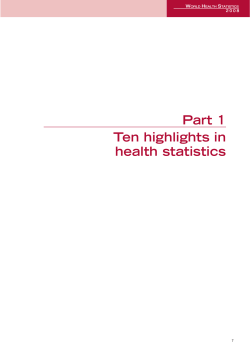
Document 178961
www.rhm-elsevier.com © 2011 Reproductive Health Matters. All rights reserved. Reproductive Health Matters 2011;19(37):117–128 0968-8080/11 $ – see front matter PII: S 0 9 6 8 - 8 0 8 0 ( 1 1 ) 3 7 5 5 0 - 7 www.rhmjournal.org.uk DISCUSSION New estimates of maternal mortality and how to interpret them: choice or confusion? Carla AbouZahr Consultant, health statistics; formerly World Health Organization staff member, Geneva, Switzerland. E-mail: abouzahr.carla@gmail.com Abstract: Two independent exercises to estimate levels of maternal mortality took place during 2010, one published by the Institute for Health Metrics and Evaluation in Seattle, USA, the other published by four UN agencies (UNICEF, UNFPA, World Bank and World Health Organization). Although both approaches are based on similar sets of empirical country data, their statistical methods differ in important respects – with implications for the resulting global, regional and country estimates. This paper examines the differences, discusses both the value and inherent limitations in such exercises, proposes ways of interpreting the different estimates and suggests how such exercises could be made more relevant to the needs of country-level decision-makers. It calls on the global community to invest seriously in working with countries to generate primary data on maternal mortality using measurement methods that reduce uncertainty and generate data on a continuing basis. The best routine source of data on maternal deaths is a civil registration system that assures permanent, compulsory and universal recording of the occurrence and characteristics of vital events, including births and deaths, and causes of death. The record of deaths among women of reproductive age derived from civil registration is often the first step in conducting a confidential enquiry into and preventing maternal deaths. ©2011 Reproductive Health Matters. All rights reserved. Keywords: maternal mortality, statistical modelling, vital statistics, health policies and programmes 2 010 was the year of maternal mortality estimates. In April, the Lancet published maternal mortality figures developed at the Institute for Health Metrics and Evaluation (IHME), an academic institution based at the University of Washington, Seattle, USA.1 In September, a different set of numbers was issued by UN agencies UNICEF, UNFPA, World Bank and World Health Organization, working in collaboration with technical experts from the University of Berkeley, California, USA.2 Both sources included data for nearly all countries (IHME 181, UN 174), along with regional and global totals. Both covered similar time spans (IHME 1980–2008, UN 1990–2008). Both calculated overall and annual average rates of change. Both claimed to be based on a systematic review of all available data. Both applied adjustments to countryreported data in order to improve comparability and correct for bias. Both used statistical modelling to generate estimates for countries or time periods where data are lacking. Both acknowledged the important impact that HIV has had on maternal mortality, especially in sub-Saharan Africa. Both claimed to have found substantial declines in maternal mortality in recent years. Both included estimates of uncertainty around the numbers. Despite these broad measures of agreement, there are important differences, both in the regional and global totals and in the individual country estimates. So what is a potential user to make of these two sets of numbers? Is one superior to the other? How can users choose between the 117 C AbouZahr / Reproductive Health Matters 2011;19(37):117–128 two? Why are the UN estimates for 2008 so different from those issued in 2005? For those confused by the sudden upsurge in numbers – and you are not alone – here are some frequently asked questions and answers that may help in understanding, and using, the new estimates. What are the differences between the two sets of numbers? • Globally, the differences in maternal deaths are small In terms of numbers of maternal deaths in 2008, the difference between the two sets of estimates is around 4%. IHME estimated some 342,900 maternal deaths compared with UN estimates of 358,000. • Uncertainty ranges are significantly different With regard to the estimates of the maternal mortality ratio (MMR), IHME estimated 251 per 100,000 live births in 2008 (range 221–289) compared with the UN estimate of 260 (range 200–370). As is clear from Figure 1, the uncertainty range is wider for the UN estimates than for those developed by IHME. This is due to the statistical methods used to calculate uncertainty, but does not mean that the UN estimates are inherently less precise that IHME's; both are uncertain. • Rates of change are significantly different An important difference between the two sets of estimates is the rate of change since 1990. IHME estimated a global annual average rate of decline between 1990 and 2008 of 1.3%, (range 1.0, 1.5) compared with a decline of 2.3% estimated by the UN agencies (range 2.1, 2.4).* The explanation lies in the differences in the estimated 1990 starting point, with IHME estimating a 1990 maternal mortality ratio of 320 per 100,000 compared with the UN estimate of 400 per 100,000 (Figure 2). Either way, both sets of estimates show rates of change well below the annual 5.5% decline that would be needed to attain the MDG5 target. It is worth noting that an attempt in 2005 by the UN agencies to estimate rates of change suggested an annual rate of decline between 1990 and 2005 of only 0.4% overall, but 2.5% when limited to countries with several empirical data points.3 • There are important differences in country estimates Whereas the global figures and trends appear broadly similar, there are important differences when it comes to individual country values. IHME estimates are higher than UN estimates in some countries; the reverse is true in others (Figure 3). *However, IHME estimated a rate of decline in a “no HIV scenario” of 2.4% annually. 118 C AbouZahr / Reproductive Health Matters 2011;19(37):117–128 What are the causes of these differences? The differences between the two sets of countrylevel estimates are largely due to: • Differences in the underlying empirically available data. • The way available data are adjusted to account for bias. • The way deaths among HIV-positive pregnant women are dealt with. • The use of different estimates of total deaths in women of reproductive age. • The specifications of the statistical models used to generate missing values. • Underlying data availability The IHME and UN estimates are based on somewhat different country-reported data. Of course, both groups made every effort to take into account as many country data points as possible in developing their estimates. The UN constructed a database of 484 empirical data observations, several of which covered multiple years, thus generating 2961 country-years of data. The IHME database of 2651 observations was constructed by analysing microdata from surveys covering multiple years to generate individual values for each year. Because data points were counted in different ways, the databases are not strictly comparable. Inevitably, there will be data points that have been missed by one group or the other and this will give rise to differences in the final estimates. However, the impact of such differences is generally small and could be reduced further by sharing databases more effectively than has been the case up to now. • Data adjustment procedures A more important source of difference between the two sets of estimates is the way countryreported data were handled. Both the IHME and the UN estimates took as the starting point not the maternal mortality ratio itself but, rather, the proportion of all deaths occurring in women of reproductive age due to maternal causes (PMDF). Both groups adjusted these data to account for biases and misreporting, for example due to misclassification of maternal deaths to other causes. In adjusting data from civil registration, IHME conducted a detailed empirical examination of deaths classified to “ill-defined and unspecified causes”. The UN adjustment to the PMDF derived from civil registration was based on a review of published literature on the extent of misclassification of maternal deaths reported in reproductive age mortality studies.4,5 Interestingly, the two different approaches came up with similar estimates of misclassification, 119 C AbouZahr / Reproductive Health Matters 2011;19(37):117–128 leading to a 40% increase in maternal deaths in the IHME study compared with 50% in the UN estimates. Two adjustments were applied to the PMDF derived from surveys, an upward one to account for under-identification of maternal deaths due to abortion, and a smaller downward adjustment to account for “incidental” deaths, that is, deaths in pregnant women that were not related to or aggravated by the pregnancy. According to the ICD definitions, these should not be counted among maternal deaths (see Box 1). The resulting upward and downward adjustments to the PMDF were almost identical, resulting in a net change of around 1%. At each step there is room for debate about the choices made and, inevitably, a degree of subjectivity is involved. For example, both datasets initially included data elements determined, following qualitative review, to be “implausible” or “outliers”. These were not subsequently included in the estimation process. Unlike the IHME exercise, the UN estimation also excluded all sub-national data sets. • Deaths in HIV-positive pregnant women The two sets of estimates also have different ways of dealing with HIV infection in pregnant women and its impact on overall maternal mor- tality. The IHME analysis used HIV prevalence as a covariate for the model. The UN approach was to take available data on total deaths in women of reproductive age as the starting point, and apply a statistical model and various assumptions to generate estimates of HIV-associated maternal deaths. • The envelope of deaths of women of reproductive age Perhaps the single most important difference in methods is the way the proportion of maternal deaths among women of reproductive age predicted by the statistical model was used to calculate total maternal deaths. Because few developing countries have reliable counts of deaths by age and sex, total deaths of reproductiveage women are usually estimated from life tables. However, IHME and the UN used different life tables and this is an important source of the differences between the two sets of data. The IHME developed country-specific life tables for adult female mortality, taking into account available survey data on sibling survival, adjusted using the Gakidou-King procedure to correct for survivor bias. 6 The UN estimates, on the other hand, used existing published UN estimates of adult female mortality as the envelope. Unfortunately, it is not possible to quantify the effect of this factor on the overall maternal mortality numbers, because to date IHME has not published the details of its envelope estimates. • Statistical model specifications Both sets of estimates used statistical models to predict values for countries and/or time periods for which empirical data are not available. Inevitably, differences in statistical methods, model specifications and covariates give rise to different results. The UN estimates were derived from a multilevel regression model that included random elements at the level of observations, countries and regions. In simple terms, the model takes into account both the nature of the underlying empirical data as well as country and regional specificities. The underlying empirical data drive the overall level of maternal mortality but the covariates, especially GNI per capita are major drivers of the trends over time. The IHME used a two-stage approach: a linear model and a spatial-temporal model 120 C AbouZahr / Reproductive Health Matters 2011;19(37):117–128 designed to capture real systematic variation not captured by covariates. In the UN analysis, covariates included Gross National Income (GNI) per capita, general fertility rate and proportion of deliveries attended by a skilled health worker. IHME covariates included total fertility rate (TFR), GNI per capita, HIV seroprevalence, neonatal mortality, agespecific female education, and age. Skilled birth attendance was included but did not add to predictive validity. In practice, GNI is the most significant driver of trends in both sets of estimates. It is important that this finding not be misinterpreted: it does not imply that improvements in maternal mortality are simply a matter of increasing national wealth as opposed to other interventions, such as access to reproductive and maternal health care. The statistical model is descriptive rather than explanatory. In several instances, the modelled estimates are based on no country-specific data related to maternal mortality, and trends are entirely driven by changes in the covariates, especially GNI per capita. Examples include Angola and Equatorial Guinea (no empirical data), Lao PDR (one data point for 1990), and Myanmar (no empirical data). This is a major weakness in both sets of estimates. The apparent decline in maternal mortality in a country such as Equatorial Guinea, for example, seems to be entirely a matter of changes in national income due to the rising price of oil and has little to do with interventions to reduce maternal mortality. It is legitimate to ask whether one statistical approach is better than the other but perhaps this is the wrong question. In both models the underlying data inputs are sparse and biased, the definitions used are inconsistent, the modelling is complex and the uncertainty of the resulting estimates is large. The big problem that needs to be addressed is the absence of country level data which no amount of tinkering with statistical models can overcome. How do the 2008 estimates differ from those issued previously by the UN? This paper is focused on the differences between the estimates issued by the UN and IHME for 2008. It does not directly address the differences between the UN estimates for 2008 and those issued previously by the UN for 1990, 1995, 2000 and 2005. As noted in the documentation accompanying each set of UN estimates, the data adjustment and statistical methods used on each occasion differed and the resulting global, regional and country estimates should not be considered as comparable. Having said this, there are a number of constants in the approaches used by the UN since 1990. These include the focus on the PMDF rather than on the maternal mortality ratio and the adjustments applied to empirical country data depending on the source and methods used. The innovations in the 2008 UN estimates approach include a more rigorous effort to account for “incidental” deaths among pregnant women, including those due to HIV, and a more complex statistical modelling approach designed to better estimate both levels and trends in maternal mortality. Why are the estimates often so different from those reported by countries? Both the IHME and UN estimates aim to maximise comparability, both over time and across countries. But this is difficult when countryreported data derive from different sources and data collection methods, use different definitions, and have varying time reference points. For example, when maternal mortality is derived from the census or from household surveys, what is actually measured is pregnancy-related mortality rather than maternal mortality (Box 1).7 Depending on the data source, the resulting figures relate to different definitions and different time periods and have different levels of precision and reliability (Table 1). In some countries, maternal mortality is reported through the civil registration system but unless coverage is almost complete (at least 90%) and all deaths are properly medically certified, the resulting data are likely to be serious undercounts.8 Elsewhere, household surveys are used as the data source, using either direct or indirect (sisterhood) measurement methods. These generate values that have important uncertainty bounds, due to a combination of sampling and non-sampling errors. In other settings, the census is used to estimate maternal mortality but here too, there are likely to be problems of under-reporting; mortality data derived from the census need to be reviewed and adjusted using demographic techniques, something that not all countries do systematically.9 121 C AbouZahr / Reproductive Health Matters 2011;19(37):117–128 122 C AbouZahr / Reproductive Health Matters 2011;19(37):117–128 Many of the difficulties associated with monitoring maternal mortality arise from the fact that maternal deaths are relatively rare events, only about 5% as common as child deaths. The small numbers involved mean that national trends tend to be unstable, and sub-national ones even more so. This is especially true when mortality levels are very low and when household surveys are used as the data source. In countries with very small absolute numbers of maternal deaths, changes of one or two deaths in the numerator can appear to have a disproportionate effect on the maternal mortality ratio. Estimates generated using surveys are themselves subject to wide variations, which are not always described in the country reports (Figure 4). Can the estimates be used for both country and global monitoring? The impetus to obtain better data to track progress began to grow following the 1990 Child Survival Summit, and has been further magnified by monitoring and evaluation related to the Millennium Development Goals. Both the IHME and the UN estimates sought to address two challenges: (1) how to bring together, in a common format and using similar sets of assumptions, data for multiple time periods and from diverse data sources in order to generate a set of figures comparable across countries and over time; and (2) how to predict maternal mortality in countries and for time periods with no empirical data. Both statistical models generate figures for country settings where no primary data are available and they produce updated, future or retrospective values, such as for the MDG base year of 1990. The results of these global estimation exercises should be used carefully. Estimates generated using statistical “forecasting” and “far-casting” techniques can be used for advocacy, planning, strategic decisions, and identifying research and development priorities. However, they should not be used for monitoring progress towards agreed targets and for an assessment of what is effective and what is not.10 What country decision-makers actually need are data that are accurate, frequent and rapidly available at national and sub-national levels. Such data are essential to identify whether and to what extent their policies and programmes are achieving the anticipated results. Estimates based on statistical models do not answer these needs. 123 C AbouZahr / Reproductive Health Matters 2011;19(37):117–128 Do these new estimates mean that more data on maternal mortality are now available? In their MDG reports, UN agencies have regularly drawn attention to the paucity of reliable and comparable country data and the ensuing challenge for monitoring progress.11 The IHME study contests the claim that maternal mortality is inherently hard to measure, noting that “More data are available for maternal mortality than for other main causes of child or adult death… the number of data points directly measuring tuberculosis as a cause of death is much lower than that for maternal mortality. A comparison… with HIV and many causes of child mortality is similarly favourable.”1 There is some truth in this statement. The maternal mortality ratio has been an international target at least since the 1990 World Summit for Children and researchers have devoted considerable attention to developing measurement approaches, such as the sisterhood method.12 Despite this, at country level, maternal mortality data are sparse. In the UN database, during the period from the late 1980s to 2008, there were an average of only 2.8 observations per country.13 The paucity of cause-specific mortality data is a widespread challenge. Despite the growing attention directed to measuring mortality due to AIDS, TB and malaria, monitoring is usually limited to indicators of disease incidence and prevalence and access to preventive and/or treatment interventions such as insecticide-treated mosquito nets, coverage of TB treatment, and people in need receiving antiretroviral therapies for advanced HIV infection. The successes achieved in recent years in methods to measure child mortality have not been matched by similar progress in tackling the measurement challenges for causes of death or for adult mortality overall. Why are there two sets of estimates anyway? Would it not be better to have just one agreed set of estimates? Until 2010, UN agencies took the lead on developing global estimates, not only for maternal mortality but for child mortality, HIV and TB incidence and prevalence and other health indicators. The arrival of the IHME – an academic group based at the University of Washington in Seattle and funded largely by the Bill and 124 Melinda Gates Foundation – has important implications, many positive, others less so. On the one hand, the scientific method is defined by innovation, transparency, critical evaluation and the confrontation of alternative hypotheses. On the other hand, what is good from a scientific point of view may be less so from a country perspective, where multiple, often contradictory estimates create confusion and scepticism which need to be avoided. Both the UN and IHME bring together technical expertise from around the world in order to ensure a strong scientific foundation for their work. In this instance, this gave rise to differences of opinion on the most appropriate statistical methods. Disagreements and debate are a normal part of scientific discourse and can help improve the knowledge base and stimulate better empirical data collection in country. Forcing a scientific consensus around estimates that are characterised by a high degree of uncertainty is not the way forward. But it is incumbent upon the agencies and academic institutions undertaking such work to minimise confusion and maximise transparency by sharing data and openly debating statistical methods and data adjustments. Moreover, the production of estimates should go hand in hand with the development of tools and methods that build capacity in countries for data generation, analysis and interpretation. Furthermore, there has been a spirit of competitiveness and unseemly haste in the release of estimates, often linked to high profile political events such as the meetings of the G8 in June in Canada (which included special attention to maternal and child health)14 and the UN General Assembly in September 2010 (which focused on progress towards the MDGs.)15 The publication of the IHME results in the Lancet was criticised for a rushed peer review process.16 The UN estimates were released independently, bypassing peer review journals and provoking critical comments in the Lancet.17 Are there risks involved in these global estimation exercises? Global estimation efforts have some negative, unintended consequences, especially at country level. Neither the UN nor the IHME involved scientists or institutions from developing countries. Because of this lack of country engagement in C AbouZahr / Reproductive Health Matters 2011;19(37):117–128 and ownership of the process, the resulting estimates are perceived as externally managed, data-mining exercises, bringing few benefits to countries themselves. The UN process did involve a measure of country consultation, but this was insufficient to build capacities for data analysis and interpretation. For country policymakers, the existence of different values for same indicators creates confusion and risks fostering a culture of “gaming” around the various figures. Global estimates also discourage a culture of local accountability: if external institutions produce country numbers, there is no need to allocate resources in country to generate empirical data. On the other hand, if no estimate is available, national policy-makers have an excuse for inaction. Following the release of the estimates, both the IHME and the UN agencies have sponsored inter-country workshops designed to enhance understanding of the rationale and methods for the estimates. This is a welcome development but sadly, the two groups are still working entirely separately. What a missed opportunity! Global estimation efforts can only benefit from direct discussions of the methods on a shared platform with country data producers, technical experts and data users. The maternal health community should advocate for better collaboration in any future country workshops. Should UN agencies leave estimation to academic institutions? In the light of these debates, questions have been raised as to whether the UN agencies should continue to invest resources in global estimation. 18 The argument is made that academic institutions have stronger scientific integrity, are better resourced, and are independent of political pressures.19 However, arguably, the UN agencies can draw on a broad range of scientific expertise from around the world and have a history of open discussion with countries on the availability and quality of statistical reporting.20 Indeed, it is essential that in developing estimates, the UN system should work on a strong scientific foundation and in a spirit of independence and objectivity. The Child Health Epidemiology Reference Group, 21 which produces estimates of causes of child death, and Countdown to 2015, 22 which tracks maternal and child health indicators, bring together scientists and UN agencies, but act independently in their scientific deliberations. A similar mechanism is being established for maternal health monitoring, bringing together both independent technical experts and also involving UN agencies.23 There are other reasons why the UN should not hand over this role to external bodies. The UN system has a long history of global, regional and country-level action. Multilateral agencies are constituted by – and accountable to – national governments. This implies a time-unlimited commitment that academic institutions by themselves cannot offer. Moreover, the UN system is better positioned than academic institutions to generate productive interactions between global monitoring efforts and country information systems. UN agencies have a responsibility to incorporate country institutions and scientists into the estimation process. Countries are not simply suppliers of raw data to be analysed and adjusted by academics and technicians. Moving the focus of estimation from institutions in the “north” to actors in the “south” would enable countries to benefit from capacity-building around the collection and sharing of data, development of scientific methods of estimation, publication of estimates, and development and application of user-friendly analysis and estimation tools. What should countries do to monitor maternal mortality trends? The debate around global estimates has so focused the attention on the maternal mortality ratio that other indicators of progress have been neglected. Yet a better understanding of trends would emerge from an analysis of not only the maternal mortality ratio – a measure of obstetric risk – but also of indicators that reflect the frequency at which women are exposed to this risk or levels of fertility – reflected in the maternal mortality rate. Valuable insights about maternal health can be gleaned by examining the interplay between maternal mortality and fertility. In settings where the maternal mortality ratio (the obstetric risk) is high, the maternal mortality rate (the risk per reproductive age woman) may decline due to falling fertility. A decline in the absolute number of births will result in fewer maternal deaths, even without improvements in the uptake of maternal health interventions. 125 C AbouZahr / Reproductive Health Matters 2011;19(37):117–128 There is also value in tracking the numbers of deaths, especially in small countries or where the absolute number of maternal deaths is relatively small. A simple distribution of numbers of deaths by time of occurrence (during pregnancy, during the intra-partum period, and post-partum) provides valuable information for policy and programming. Moreover, each death can serve as the starting point for audits and confidential enquiries that describe the circumstance and causes of each death and identify ways of averting such deaths in the future.24 In addition, indicators of health care should be monitored, such as use of skilled birth attendant at delivery, levels of fertility, nutritional status, and availability and use of essential obstetric care. These data may well be more readily available on a regular basis than mortality indicators. Is maternal mortality really difficult to measure or are we just not trying? The reliance on global estimates and the fact that maternal deaths are so poorly counted, are symptomatic of a broader problem, the neglect of the poorest and most vulnerable in society and the lack of attention to their health and survival – the so-called “scandal of invisibility”.25 It is time for the global community to invest seriously in working with countries to generate primary data on maternal mortality using measurement methods that reduce uncertainty and that generate data on a continuing basis, rather than at occasional intervals. This is not just an issue for maternal mortality but applies more generally across all causes of death. Good public health decision-making and accountability, in order to make progress towards health targets, are dependent on reliable and timely statistics on births and deaths, including assessment of causes of death. The best routine source of data on maternal deaths is a civil registration system that assures the continuous, permanent, compulsory and universal recording of the occurrence and characteristics of vital statistics, including births and deaths, and causes of death.26 Civil registration has a dual purpose, administrative and legal on the one hand, and statistical, demographic and epidemiological on the other. For the individual, the civil statistics records of birth or death provide essential legal documentation for a wide range of purposes. From a population perspective, birth and death records can provide important public health information. Vital statistics derived from civil registration are the only nationally representative, continuously available source of information on cause-specific mortality. The record of deaths among women of reproductive age derived from civil registration is often the first step in conducting a confidential enquiry into maternal deaths. The UN Commission for Information and Accountability for Women's and Children's Health is calling on countries and development partners to prioritize investments for building robust health information systems to monitor women's and children's health, with a focus on the systems needed to generate data on births, deaths, and causes of death.27 The Health Metrics Network28 has launched an initiative to strengthen national civil registration and vital statistics systems in order to better monitor vital events. Through a combination of global advocacy; development of innovative solutions for registering births and deaths and tracking pregnancy outcomes, and compiling the lessons learnt from these experiences, countries will be empowered to generate their own primary data. Perhaps then, the global community will be able to dispense with statistical estimation models. References 1. Hogan MC, Foreman KJ, Mohsen Naghavi AB, et al. Maternal mortality for 181 countries, 1980–2008: a systematic analysis of progress towards Millennium Development Goal 5. Lancet 2010;375(9726): 1609–23. DOI: 10.1016/ S0140-6736(10)60518-1. 126 2. WHO, UNICEF, UNFPA, World Bank. Trends in maternal mortality: 1990 to 2008. Geneva: WHO; 2010. 3. World Health Organization. Maternal mortality in 2005: estimates developed by WHO, UNICEF, UNFPA, and the World Bank. Geneva: World Health Organization; 2005. 4. Horon IL. Underreporting of maternal deaths on death certificates and the magnitude of the problem of maternal mortality. American Journal of Public Health 2005;95:478–82. 5. Lewis G, editor. The Confidential Enquiry into Maternal and Child Health (CEMACH). Saving mothers' C AbouZahr / Reproductive Health Matters 2011;19(37):117–128 6. 7. 8. 9. 10. 11. 12. lives: reviewing maternal deaths to make motherhood safer. 2003–2005. The seventh report on confidential enquiries into maternal deaths in the United Kingdom. London, CEMACH, 2007. Gakidou E, King G. Death by survey: estimating adult mortality without selection bias from sibling survival data. Demography 2006;43(3): 569–85. WHO. International Statistical Classification of Diseases and related health conditions. 10th revision. Geneva: WHO; 1992. Deneux-Tharaux C, Berg C, Bouvier-Colle MH, et al. Under-reporting of pregnancyrelated mortality in the United States and Europe. Obstetrics and Gynecology 2005;106: 684–92. For a fuller discussion of these issues, see AbouZahr C. Making sense of maternal mortality estimates. University of Queensland Health Information Systems Knowledge Hub Working Paper, 2010 At: <www. uq.edu.au/hishub// ?page=147837>. Murray CJL. Towards good practice for health statistics: lessons from the Millennium Development Goal health indicators. Lancet 2007;369: 862–73. United Nations The Millennium Development Goals Report 2010. New York, 2010. At: <www.un.org/millenniumgoals/ pdf/MDG%20Report%202010% 20En%20r15%20-low%20res% 2020100615%20-.pdf>. Graham W, Ahmed S, Stanton C, et al. Measuring maternal 13. 14. 15. 16. 17. 18. 19. 20. 21. mortality: an overview of opportunities and options for developing countries. BMC Medicine 2008;6:12. DOI:10.1186/1741-7015-6-12. Wilmoth J. Technical paper on maternal mortality estimation 2011. (Forthcoming) Accountability Commission for Health of Women and Children. At: <www.who.int/topics/ millennium_development_ goals/accountability_ commission/en/>. Accessed 30 November 2010. United Nations Summit on the Millennium Development Goals. 20–22 September 2010. At: <www.un.org/en/mdg/ summit2010/>. Accessed 30 November 2010. Graham WJ, Braunholtz DA, Campbell OM. New modelled estimates of maternal mortality. Comment on: Lancet 20108;375 (9726):1609–23. In: Lancet 2010;375(9730):1963. Author reply 1968. Soul searching at the UN [Editorial]. Lancet 2010; 376(9746):1026. PLoS Medicine Editors. Can we count on global health estimates? PLoS Medicine 2010; 7(11):e1001–02. DOI:10.1371/ journal.pmed.1001002. Murray CJL, Lopez AD. Production and analysis of health indicators: the role of academia. PLoS Medicine 2010; 7(11):e1001–04. DOI:10.1371/ journal.pmed.1001004. Boerma JT, Mathers C, AbouZahr C. WHO and global health monitoring: the way forward. PLoS Medicine 2010; 7(11):e10003–073. DOI:10.1371/ journal.pmed.1000373. Child Health Epidemiology Reference Group. At: <http:// 22. 23. 24. 25. 26. 27. 28. cherg.org/main.html>. Accessed 10 February 2011. Countdown to 2015. At: <www. countdown2015mnch.org/>. Accessed 10 February 2011. World Health Organization. Meeting of the Maternal Mortality Estimation Inter-Agency Group and the Technical Advisory Group on Maternal Mortality Estimates. Geneva: WHO, UNICEF, UNFPA, World Bank; 26–27 January 2011. World Health Organization. Beyond the Numbers: Reviewing Maternal Deaths and Complications to Make Pregnancy Safer. Geneva: WHO; 2010. ISBN 92 4 159183 8 (NLM classification: WA 900). Setel P, Macfarlane S, Szreter S, et al. A scandal of invisibility: making everyone count by counting everyone. Lancet 2007;370(9598):1569–77. DOI: 10.1016/S0140-6736(07) 61307-5. United Nations. Principles and Recommendations for a Vital Statistics System. Revision 2. New York: UN Statistics Division; 2001. Sales No. 01.XVI.10. WHO. Accountability Commission for Health of Women and Children. At: <www.who.int/topics/ millennium_development_ goals/accountability_ commission/en/>. Accessed 21 February 2011. Health Metrics Network streamlines to focus on recording vital events and tracking progress towards stronger health information systems. At: <www.who.int/ healthmetrics/en/>. Accessed 21 February 2011. 127 C AbouZahr / Reproductive Health Matters 2011;19(37):117–128 Résumé Deux analyses indépendantes destinées à estimer les niveaux de mortalité maternelle ont été publiées en 2010, l'une par l'Institute for Health Metrics and Evaluation à Seattle, États-Unis d'Amérique, l'autre par quatre institutions des Nations Unies (UNICEF, FNUAP, Banque mondiale et OMS). Même si les deux approches sont fondées sur des ensembles similaires de données nationales empiriques, leurs méthodes statistiques diffèrent sur des points importants, avec des conséquences sur les estimations mondiales, régionales et nationales ainsi obtenues. Cet article examine les divergences, discute de la valeur et des limitations inhérentes à ces opérations, propose des interprétations des différentes estimations et suggère des moyens de mieux adapter ces études aux besoins des décideurs nationaux. Il invite la communauté internationale à investir véritablement dans le travail avec les pays en vue de créer des données primaires sur la mortalité maternelle au moyen de méthodes de mesure qui réduiront l'incertitude et produiront des données de manière continue. La meilleure source systématique de données sur les décès maternels est un système obligatoire et généralisé de registre d'état civil qui consigne en permanence les naissances, les décès et les causes des décès. La comptabilisation des décès survenus chez les femmes en âge de procréer, figurant dans les registres d'état civil, est souvent la première étape pour réaliser une enquête confidentielle sur la mortalité maternelle et la prévenir. 128 Resumen En 2010 se realizaron dos ejercicios independientes para calcular los niveles de mortalidad materna: uno publicado por el Instituto de Métrica y Evaluación en Salud, en Seattle, EE. UU.; el otro, por cuatro organismos de la ONU (UNICEF, UNFPA, el Banco Mundial y la Organización Mundial de la Salud). Aunque ambos enfoques se basan en similares datos empíricos, sus métodos estadísticos difieren en importantes aspectos, con implicaciones para los consiguientes cálculos nacionales, regionales e internacionales. En este artículo se examinan las diferencias, se discute tanto el valor como las limitaciones inherentes en dichos ejercicios, se proponen maneras de interpretar los diferentes cálculos y se sugiere cómo lograr que estos ejercicios sean más pertinentes para las necesidades de las personas responsables de tomar decisiones en cada país. Se hace un llamado a la comunidad global para que colabore con los países a fin de generar datos principales sobre la mortalidad materna empleando métodos de medidas que disminuyan la incertidumbre y generen datos de manera continua. La mejor fuente rutinaria de datos sobre las muertes maternas es un sistema de registro civil que asegure el registro permanente, obligatorio y universal de la incidencia y características de estadísticas vitales, como nacimientos y muertes, así como las causas de defunción. El registro de muertes de mujeres en edad reproductiva derivado del registro civil suele ser el primer paso para la investigación confidencial y prevención de las muertes maternas.
© Copyright 2025
